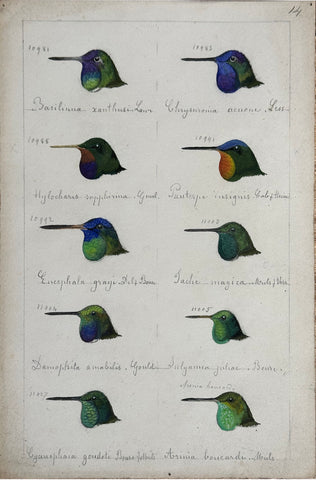
Prideaux John Selby (British, 1788-1867), “Starling”
“Starling”
Original watercolor prepared for Plate 36 of Illustrations of British Ornithology
Watercolor, gouache, pencil and ink on paper
Signed ‘P.J. Selby’ l.r., inscribed ‘Starling’ l.l.
Paper size: 12 3/4 x 9 1/2 in.
Frame size: 32 1/2 x 29 in.
London, ca. 1820
Provenance: Library of H Bradley Martin..
Selby wrote of the Starling: “The Starling is widely dispersed through Great Britain, occurring as numerously in the Orkney and Shetland Isles as in the southern parts of the kingdom.
In the autumnal and hyemal months, these birds gather in immense flocks, and are particularly abundant in the fenny parts of Nottinghamshire and Lincolnshire, where they roost among the reeds. Before they retire to rest, they perform Various manoeuvres in the air, the whole frequently describing rapid revolutions round a common centre.
This peculiar flight will sometimes continue for nearly half an hour, before they become finally settled for the night.
Upon the approach of spring they pair, and spread themselves over the country. — They build in the holes of trees, or in ruinous buildings, making an artless nest of dry grass or hay, on which four or five eggs, of a bluish-green colour.
Their food principally consists of worms and other insects; but they also eat grain and various seeds. According to Mr Low, they feed in the Orkney Islands, during the severity of winter, upon the sea-louse [Pnucua marinus), which they obtain by turning over the small stones on the beach with their bills.
The Starling is a very imitative bird, and, when tamed, may be taught to articulate very distinctly, and to whistle tunes with much precision. In its wild state even, it may frequently be heard endeavouring to imitate the cries of different birds and animals. Its own peculiar notes are a shrill whistle, and chattering kind of noise. It is found through-out Europe; and the same species appears to be common also in Asia, as I have seen specimens from Nepaul that are precisely similar. — The flight of the Starling is smooth and even, without any saltatory motion ; and it walks with ease, like the Lark or Wagtail, seldom or never using the hopping action of the Thrush. These birds are often seen in company with Rooks, Pigeons, and Jackdaws, and I have witnessed a small flock of them associating for a considerable time with a body of Lapwings ( Vanellus cristatus.)
Plate 36. Fig. 1. A male bird, of the natural size.
General plumage black, with brilliant purple and golden- General green reflections, the feathers .tipped with triangular white, or cream-yellow spots. Quills and tail-feathers greyish-black, with the margins pale reddish-brown. Bill lemon-yellow. Legs flesh-red; in some inclining to yellowish-brown.
The female differs in having a greater number of white spots upon the back and belly.
The young birds, previous to autumn, or the first moult, are of a uniform hair-brown colour, lightest upon the throat and under parts. In this state it has been described by Montagu and Bewick as a distinct species, under the name of the Solitary Thrush.”
Considered by many as the English equivalent of Audubon, Prideaux John Selby created some of the most memorable bird images of the nineteenth-century. His contributions to British ornithology were rivaled only by those of John Gould. Yet, his pictures were larger and less purely scientific, exhibiting Selby’s distinctive and charming style. A sense of Selby’s enthusiasm for his subjects is nowhere more palpable than in his engaging original watercolors. Selby executed these delightful images as preparatory models for his landmark printed series, Illustrations of British Ornithology. While the artist’s engraved work is highly desirable to collectors, Selby’s original watercolors rarely become available. This selection of watercolors, moreover, comprises several of his masterpieces. The distinctive birds are depicted in profile, their forms delineated by softly modulated tones of black and gray wash. The setting, if present, is lightly but skillfully painted to not distract from the birds themselves. The skill and delicacy of Selby’s touch, his keen powers of observation, and his artistic sensitivity are conveyed here in a way they are not in his printed work. Several of the drawings are by Selby’s brother-in-law, Robert Mitford, but signed in Selby’s hand.
Born in Northumberland and educated at University College, Oxford, Selby was a landowner and squire with ample time to devote to studying the plant and animal life at his country estate, Twizell House. As a boy, he had studied the habits of local birds, drawn them, and learned how to preserve and set up specimens. Later, Selby became an active member of several British natural history societies and contributed many articles to their journals. Although Selby was interested in botany and produced a History of British Trees in 1842, he is best known for his Illustrations of British Ornithology. Selby’s work was the first attempt to create a set of life-sized illustrations of British birds, remarkable for their naturalism and the delicacy of their execution. The British Ornithology was issued in nineteen parts over thirteen years; the book consisted of 89 plates of land birds and 129 plates of water birds, engraved by William Lizars of Edinburgh, the printer who engraved the first ten plates of Audubon’s Birds of America.
With their rich detail and tonal range, these exquisite watercolors are beautiful works by one of the foremost British bird painters. Furthermore, they represent a singular opportunity to obtain a unique piece of the highest quality by this luminary artist, from an era in British ornithological art that remains unparalleled.
or by email at loricohen@aradergalleries.
We Also Recommend





